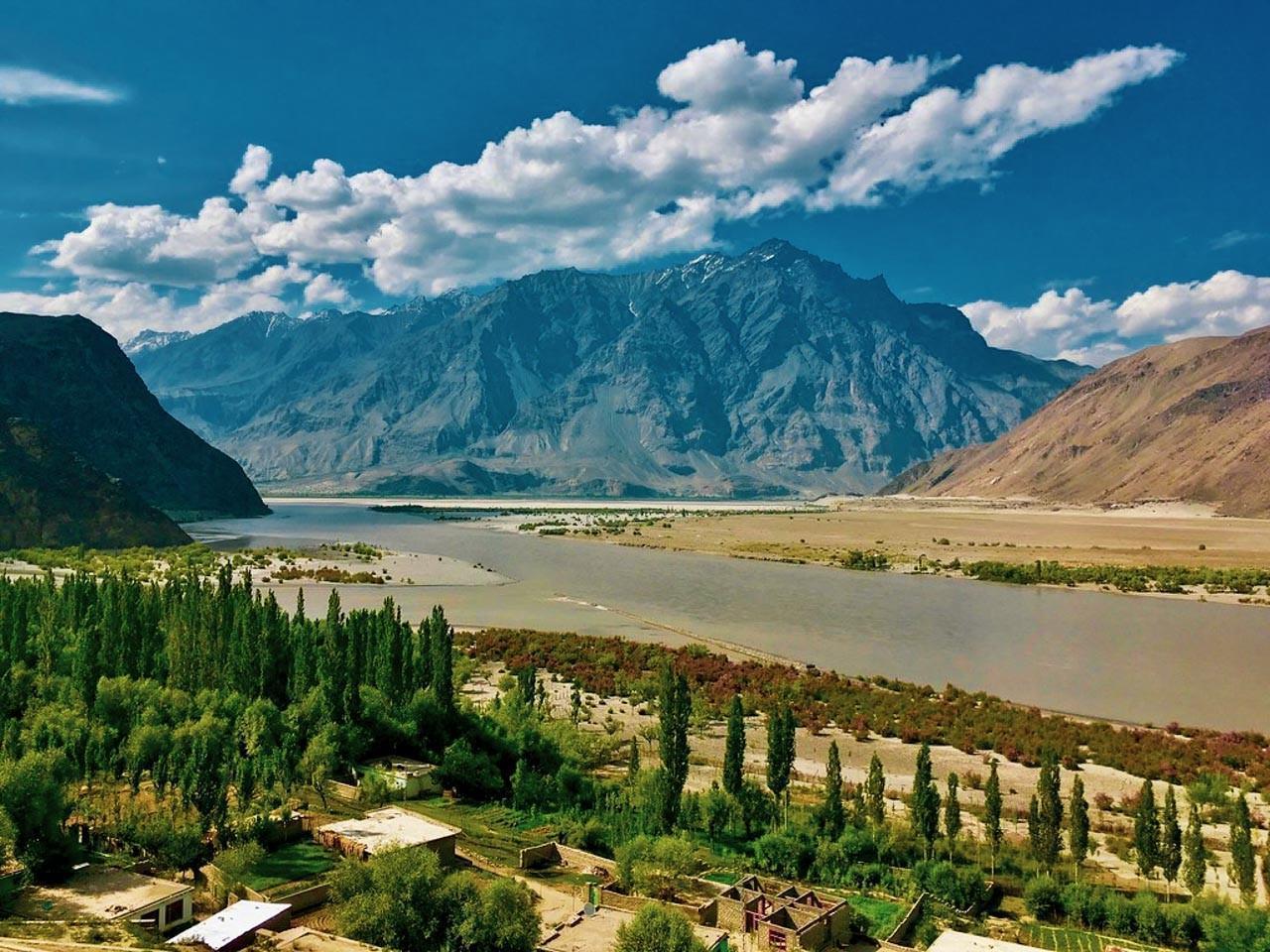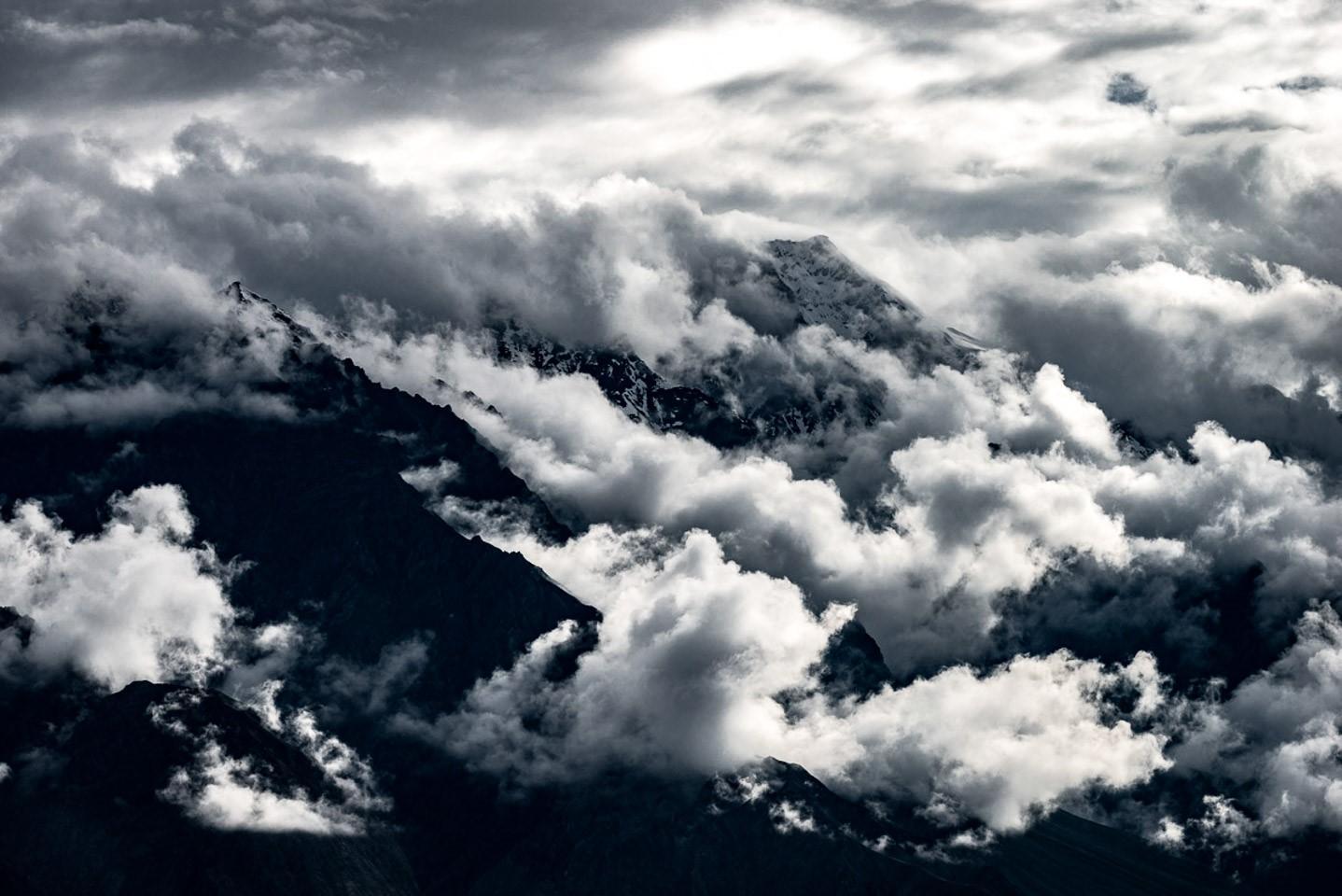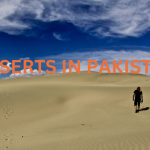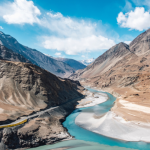The capital town of the largest district, “Skardu,” of the Gilgit-Baltistan region, Skardu Valley is surrounded by three world-famous ranges, Karakoram, Himalaya, and Ladakh. Famed as the Climber’s Paradise, Skardu Valley is the trekking hub to four of the world’s highest summits; Gasherbrum-I, Gasherbrum-II, Broadpeak, and K-2.
Skardu was historically part of the princely state of Jammu and Kashmir before the partition of British India in 1947. However, currently, it is located in the Gilgit-Baltistan region, which is a separate administrative entity within Pakistan.

Skardu Valley Overview
Skardu, located in the Karakoram mountains, is famous for its breathtaking landscapes and adventure opportunities. Known for its rugged terrain, lakes, and national parks, Skardu offers a perfect blend of adventure and relaxation. Exploring the Skardu map reveals a place with something for everyone.
Skardu and Hunza each offer unique experiences. Skardu’s beauty lies in its rugged landscapes, while Hunza is known for its lush valleys. The Skardu to Hunza distance is about 235 km. Skardu weather varies from mild summers to harsh winters, offering diverse conditions year-round.
Unveil Skardu’s magic through breathtaking landscapes, immersive cultural encounters, and thrilling adventures. This comprehensive guide is your roadmap to an unforgettable journey.
Read our recent blog on Top Must-Visit Places in Skardu for more awareness.

Weather Conditions and Climate
Summer Climate: Skardu experiences moderate temperatures with minimal rainfall. From March to September, temperatures range from a maximum of 24°C to a minimum of 4°C.
Winter Climate: Winters are severe, with temperatures dropping to -10°C from October to February.
Temperature Trends: After February, temperatures begin to rise gradually.
Best Time to Visit: The best time to visit Skardu is during the summer months, from March to September when the weather is pleasant and suitable for outdoor activities.
Top Sights in Skardu
The beauty lies in its natural landscapes, including majestic mountains, serene lakes, and the expansive Deosai plains.
Some of these top tourists’ attractions are:
- Kharphocho Fort: An ancient fort with panoramic views of Skardu and its surrounding valleys.
- Katpana Desert: Known as the Cold Desert, features stunning dunes against a backdrop of snowy mountains.
- Manthal Buddha Rock: A historic rock carving of Buddha from the 8th century.
- Manthoka Waterfall Resort: A serene spot with a picturesque waterfall surrounded by greenery.
- Soq Valley: A peaceful valley known for its natural beauty and tranquility.
- Sarfaranga Cold Desert Shigar: A unique desert with golden dunes set against mountain views.
- Italian K2 Museum Skardu: A museum that highlights the history and culture of mountaineering in the Karakoram.
- Chunda Valley: A valley renowned for its vibrant landscapes and traditional villages.
- Sheosar Lake: A high-altitude lake in Deosai National Park with clear waters and stunning scenery.
- Burji La: A mountain pass offering breathtaking views of surrounding peaks.
- Marsur Rocks Hussainabad: Unique rock formations with scenic views, perfect for photography.
- Chaqchan Mosque: One of the oldest mosques in the region, reflecting the rich Islamic heritage of Baltistan.
- Lower Kachura Lake: Kachura Lake often dubbed “Heaven on Earth,” is a 20-kilometer gem from Skardu, captivating visitors with its crystal-clear waters and stunning surroundings.
- Upper Kachura Lake: A serene lake surrounded by rugged mountains, ideal for boating and picnics.
- Deosai National Park: A vast plateau known as the “Land of Giants,” famous for its rich wildlife and stunning landscapes. Deosai Skardu Pakistan is worth visiting and it is located about 30 km from Skardu.

People of Skardu Valley
The inhabitants of Skardu belong to multiple ethnicities, mainly Baltis, and Tibetans. Commonly spoken languages are Shina, Burushaski, Balti, and Wakhi. The literacy rate is 100 percent all over the Gilgit-Baltistan region. Khaplu, Machalu, Chorbat, and Haldipa are significant villages in Skardu Valley.
The population of Gilgit-Baltistan is Muslim, the majority belonging to the Shia Sect; however, followers of Sunni, Wahabi, and Noorbakhshia sects are also found in the great majority. Ismailism is also one of the major sects whose practitioners reside in Gilgit Baltistan.
They may also invite you to stay in their homes and offer you meals. People do not accept tips; however, you can leave a small amount of money or some gift item for them as a thank-you, although it is common for them to refuse. Women are treated with respect in the conservative society of Gilgit-Baltistan, and you will not find many women outside of their houses.
Festivals in Skardu Valley
Besides the landscape, history, and culture, the flamboyance of festivals in Skardu Valley is also appealing to tourists.
Shandur Polo Festival
The Shandur Polo Festival is a traditional polo tournament held at the world’s highest polo ground, attracting teams and spectators from across the region. Polo is a traditional Balti game, which is also called “The Game of Kings” or “The King of Games.” The polo festival is held during the second week of August each year, in which the polo tournament marks the liberation of Baltistan from the Dogra rule in 1948.
Baba Ghundi Festival
The Baba Ghundi Festival celebrates the local Sufi saint with music, dance, and cultural performances, reflecting the spiritual heritage of Skardu. Held annually in the Ghund valley, the festival also includes rituals and prayers, drawing pilgrims and visitors who seek blessings from the revered saint.
Jashn-e-Baharan Festival
The Jashn-e-Baharan Festival marks the arrival of spring with cultural activities, traditional music, and sports, showcasing the vibrant culture of Skardu. The festival is a lively event where locals and tourists come together to enjoy colorful processions, folk dances, and local delicacies, welcoming the new season with joy and enthusiasm.
Jashn e Nowruz
It is celebrated in all parts of Gilgit Baltistan as the Persian new year begins. People gather to enjoy feasts; paint eggs to decorate their tables, and ladies beautify their hands with henna (a local plant ground blended with water to paint hands red)
Wildlife In Skardu Valley
|
Wildlife |
Description |
|
Himalayan Brown Bear |
Found in Deosai National Park, this endangered species is one of the largest carnivores in the region. |
|
Snow Leopard |
Rarely seen, the snow leopard roams the high-altitude areas of Skardu and is a symbol of the region’s wilderness. |
|
Ibex |
These wild goats are often spotted on steep mountain slopes, known for their impressive curved horns. |
|
Marco Polo Sheep |
Native to the high-altitude plains, this species is prized for its large, spiral horns. |
|
Golden Marmot |
Common in the Deosai Plains, these large rodents are known for their burrowing habits. |
Activities in Skardu
- Boat on Lower Kachura Lake at Shangrila Resort.
- Swim and walk around Upper Kachura Lake.
- Hike to Skardu Fort for panoramic views.
- Trek and camp in Deosai National Park.
- Paraglide over Deosai Plains.
- Rock climb near Skardu Fort and Sheosar Lake.
- Fish for trout at Satpara Lake Skardu.
- Watch polo matches at the Shandur Polo Festival.
- Experience music and dance at the Baba Ghundi Festival.
- Celebrate spring at Jashn-e-Baharan Festival.
Accessing Skardu Valley: Convenient Routes and Distances
Pakistan International Airlines (PIA) offers efficient and scenic flights to Skardu, providing travelers with a quick and comfortable journey from major cities. These include Islamabad to Skardu flight as a reliable route.
From | Mode of Travel | Distance | Travel Time |
Islamabad | By Road | Approximately 702 km | 15 hours |
By Air | About 292 km | About 1 hour | |
Lahore | By Road | Approximately 1,078 km | 18 hours |
By Air | About 550 km | About 1.5 hours | |
Peshawar | By Road | Approximately 800 km | 16 hours |
By Air | About 397 km | About 1 hour | |
Gilgit | By Road | Approximately 200 km | 4 hours |
By Air | About 170 km | About 30 minutes |
Traditional Food In Skardu Valley
- Traditional Cuisine: The traditional dish of Skardu is “Mamtu,” a type of dumpling filled with meat and spices. It is a famous and must-try for visitors and tourists alike. Other popular dishes include:
- Skardu Pulao
- Chalpak
- Fried Trout or Trout fish platter
- Seasonal fruits: This place is known for its widely grown seasonal fruits such as
- Apricots
- Apples
- Cherries
- Cultural Experiences: The local culture in Skardu Pakistan is rich with:
- Festivals like the annual Polo festival
- Traditional music featuring instruments like the Surnai and Daman
- Traditional dances like “Raqs-e-Baltistan”
- Local markets for handmade crafts and textiles
- Traditional Cuisine: The traditional dish of Skardu is “Mamtu,” a type of dumpling filled with meat and spices. It is a famous and must-try for visitors and tourists alike. Other popular dishes include:
Travel Tips for Skardu Valley
- Skardu’s temperate climate and accessible roads from April to October offer optimal conditions for exploration. While winter paints the landscape in pristine white, frigid temperatures and challenging road conditions demand specific preparations for winter sports enthusiasts.
- There are many options for Skardu hotels, ranging from budget to luxury. Some of the best hotels in Skardu include good accommodation service and mouthwatering food. Bookings in advance are essential during Skardu’s peak season to secure desirable accommodations.
- Visitors should be prepared for high altitudes and potential altitude sickness. Staying hydrated and acclimatizing slowly can help. It’s also important to check the Skardu weather forecast and road conditions before traveling.
- Pack warm clothing, sturdy hiking boots, sunscreen, a first-aid kit, and a reliable map or GPS device.
- Emergency contact numbers include Skardu Local Police: +92 5815 920145 and Skardu Emergency Number: 1122 (general emergency services in Pakistan)
Skardu, a captivating fusion of breathtaking landscapes, dynamic culture, and exhilarating adventures, promises an unforgettable experience that beckons every adventurous spirit to explore the wonders of Pakistan. From the serene lakes like Satpara Lake Skardu to the adventurous treks in Deosai, there’s something for every traveler. Plan your Skardu trip now and experience the beauty and tranquility of this incredible region.
Frequently Asked Questions
Which season is ideal for traveling to Skardu?
Skardu is best visited between October and November. The standard maximum temperature in the summertime is about 5°C (42°F); however, on the hottest days of the year, it can occasionally soar as high as 7°C (45°F). In the winter, temperatures at night time can drop as low as -34°C (-30°F).
What is Skardu famous for?
Skardu is famous for its stunning natural beauty, including majestic mountains like K2 and the Karakoram Range, picturesque lakes such as Satpara Lake and Sheosar Lake, adventure tourism activities like trekking and mountaineering, and its rich cultural heritage, with attractions like the Skardu Fort and ancient Buddhist rock carvings in nearby areas.
Can we reach Skardu by car?
Yes, one can conveniently travel to Skardu by car. The journey to Skardu can be made by road from several cities in Pakistan. The most common route is from Islamabad, which takes about 14 to 20 hours, depending on the road conditions and traffic.
Is it possible to visit Skardu Valley in winter?
Yes, Skardu Valley can be visited in winter, but it’s important to note that road access to Skardu via Naran-Babusar-Chilas road is usually closed from November to March (sometimes extending till May) due to heavy snowfall. However, air travel is still an option during these months. October is also a great month to witness the snowy landscapes and enjoy autumn colors.
Is Skardu Valley safe for tourists?
Skardu Valley is generally considered safe for tourists. The local people are known for their friendliness and hospitality towards visitors. However, it’s always advisable to take standard precautions like being aware of your surroundings, following local guidelines, and respecting the local culture and customs.
What is the approximate distance of Naran to Skardu?
The travel time from Naran to Skardu usually takes around 10-12 hours, depending on the road conditions and the number of stops that you would be taking along the way.




